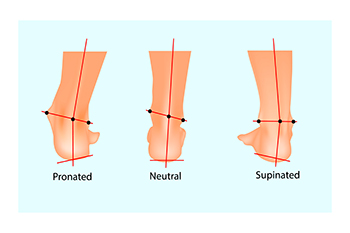
Foot pronation is a natural movement where the foot rolls inward during walking or running to absorb shock and adapt to surfaces. However, when this inward roll becomes excessive, it leads to a condition known as overpronation. It can result from flat feet or wearing improper footwear, causing the arch to collapse inward excessively. This misalignment may then lead to plantar fasciitis, shin splints, and knee pain, as it puts strain on muscles and tendons in the foot and lower leg. Conversely, underpronation, or supination, occurs when the foot does not roll inward enough, often seen in individuals with high arches. Underpronation can contribute to problems such as ankle sprains due to inadequate shock absorption. A podiatrist can identify both overpronation and underpronation by examining wear patterns on shoes and assessing gait mechanics. Treatment options include custom orthotics, specific exercises, or footwear adjustments to restore proper foot function and prevent future complications. If you have either of these conditions, It is suggested that you schedule an appointment with a podiatrist for an exam and treatment.
If you have any concerns about your feet, contact one of our podiatrists from Advanced Foot & Ankle. Our doctors can provide the care you need to keep you pain-free and on your feet.
Biomechanics in Podiatry
Podiatric biomechanics is a particular sector of specialty podiatry with licensed practitioners who are trained to diagnose and treat conditions affecting the foot, ankle and lower leg. Biomechanics deals with the forces that act against the body, causing an interference with the biological structures. It focuses on the movement of the ankle, the foot and the forces that interact with them.
A History of Biomechanics
- Biomechanics dates back to the BC era in Egypt where evidence of professional foot care has been recorded.
- In 1974, biomechanics gained a higher profile from the studies of Merton Root, who claimed that by changing or controlling the forces between the ankle and the foot, corrections or conditions could be implemented to gain strength and coordination in the area.
Modern technological improvements are based on past theories and therapeutic processes that provide a better understanding of podiatric concepts for biomechanics. Computers can provide accurate information about the forces and patterns of the feet and lower legs.
Understanding biomechanics of the feet can help improve and eliminate pain, stopping further stress to the foot.
If you have any questions please feel free to contact our offices located in Newburg and Taylorsville, KY . We offer the newest diagnostic and treatment technologies for all your foot and ankle needs.
